Menus
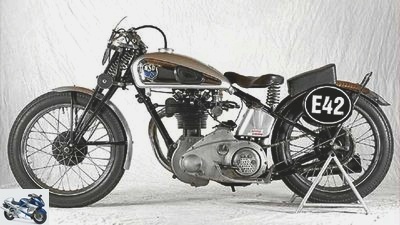
Bilski
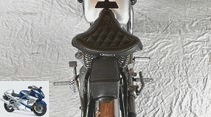
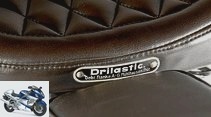

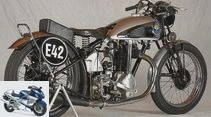
12th photos
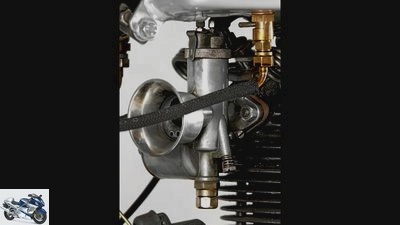
Bilski
1/12
And the NSU carburetor.
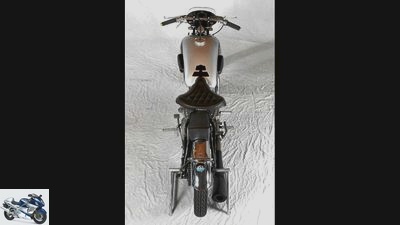
Bilski
2/12
The NSU 501 OSL in the horizontal view.
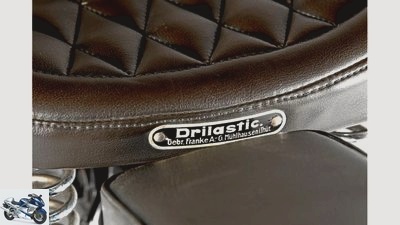
Bilski
3/12
The finely crafted leather saddle.
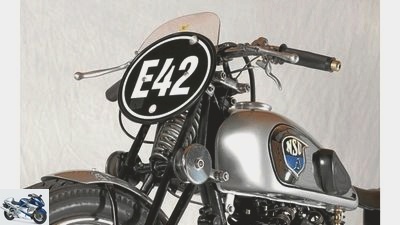
Bilski
4/12
The number E42 as a reminder of the racing history of the NSU 501 OSL.

Bilski
5/12
As few add-on parts as possible so that the NSU remains light.
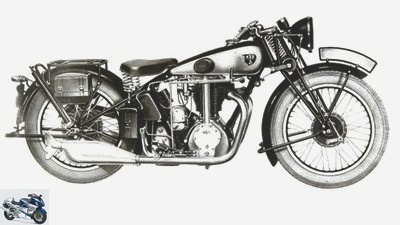
6/12
The OSL – here the 1935 vintage – was called Deutsche Norton because of its English lines.
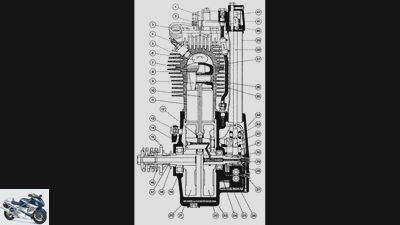
7/12
On the left of the stump of the crankshaft you can see the drive wheel with its shock absorber, on the bottom right (No. 26) the gear oil pump.

8/12
From 1938, the OSL had a closed light metal cylinder head. Thanks to the eccentrically mounted rocker arm axes, the valve clearance could be adjusted from the outside using screws.
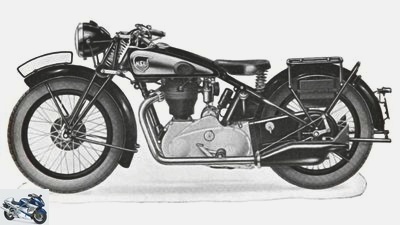
9/12
The last OSL attracted attention with its box-shaped mudguards and a closed chain case.
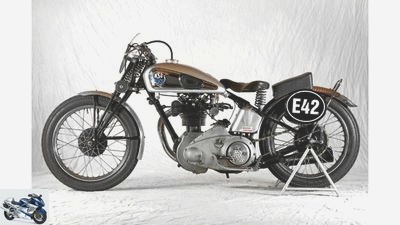
Bilski
10/12
At the beginning of the 1930s, NSU wanted to sell Tom Bullus’ racing successes, and this is how one of the most beautiful and robust sports motorcycles of the time was created.
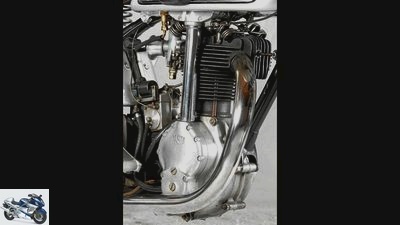
Bilski
11/12
The 30 hp engine from NSU.
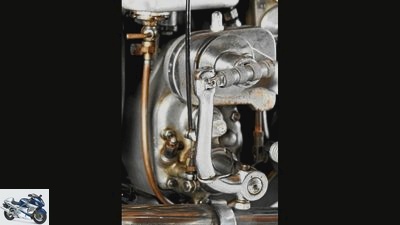
Bilski
12/12
Here the enlargement of the circuit.
In the studio: NSU 501 OSL
The German Norton
Content of
Walter W. Moore, the father of the Norton CS1, was responsible for NSU racing motorcycles and subsequent series offshoots from 1930. This copy looks back on an eventful history.
The babble of voices can be heard in the MOTORRAD CLASSIC editorial office: “Bastard moped”, some grumble, “Which models and years have come together here?”, The others want to know: The one shown NSU 501 OSL was built in 1936, when hairpin springs closed the valves. Previously, coil springs were used, then the so-called motorway-proof engine with heavily ribbed light metal cylinder head and encapsulated valve train. An early owner was obviously keen to at least optically convert the vehicle to the 501 SS Supersport that was available for sale, which in turn was clearly based on the 30 hp 501 SSR “Bullus” racing motorcycle. The SSR owes its nickname to the English racing driver Tommy Frederic Bullus, who hurried from victory to victory for the NSU racing team in 1930 and 1931.
But back to the photo model: Originally the 501 OSL had a double port cylinder head and two exhaust pipes with a fishtail mouth. The single tube that can be seen here indicates the single-port head as worn on the racing machine – and that version of the Supersport with which private racing drivers preferred to hunt for times. Both the SSR and the SS drove their overhead camshaft via a vertical shaft. At the OSL, bumpers were used, the thick jacket tube of which establishes an optical relationship to the vertical shaft variant. The flat tank and the seat cushion on the rear fender can also be seen as an homage to the SSR. The gearshift pedal follows the English tradition and, like the kickstarter, sits on the right.
After the Second World War, the photo motorcycle found itself on the other side of the iron curtain and started in veteran races of the General German Motorsport Association. Although the machine had been massively modified, the ADMV had no fundamental reservations; however, the approval document for veteran races in the GDR is comprehensive. Despite the basically simple and robust technology, the mechanics who could service a pre-war NSU became more and more rare over the years. After the OSL injured two hard-working helpers while competing, their career was over for the time being. Today it is ready to drive in a private collection in Oettingen.
The model history
archive
The OSL – here the 1935 vintage – was called Deutsche Norton because of its English lines.
When England was still the center of the motorcycle world, because every major brand competed in the Tourist Trophy, Triumph was allowed to call itself the largest manufacturer and even the boys dreamed of Norton, Ariel, Rudge or Brough, NSU had a problem: The Neckarsulmers were looking for theirs in 1929 Consolidation phase – Heilbronner car factory sold to Fiat, everyday motorcycles on the rise – a designer for a racing motorcycle that was worth winning and advertising. The search ended with Walter William Moore, and his work resulted in a single that made its debut in 1930 at the Nurburgring under Tom Bullus with a fourth place. Both gentlemen were British, of course.
The new NSU looked like a Norton CS1, which shouldn’t come as a surprise because it was also from Moore. As a result, the overhead camshaft was driven here as there by a vertical shaft and bevel gears. Bullus and NSU continued to clear away properly, winning at the Solitude, the Schauinsland and the Monza Grand Prix, among others. In 1931, the factory presented a replica called the 500 SS to private drivers and wealthy sports fans, a few hundred of which were sold in a few hundred individually equipped and tuned copies. The audience kept waiting.
Of course, the global economic crisis, which was just easing, inhibited the spirit of enterprise, solid and small-volume workhorses were better suited to the times than expensive sports motorcycles. But with a healthy vision, NSU operator Fritz von Falkenhayn anticipated the upswing and in 1931 placed the order for the development of an ohv-controlled single-cylinder series. First the 501 OS appeared in the following year, soon followed by the technically almost identical 351 S (see MOTORRAD CLASSIC 2/1993) and the top sellers with 250 and 200 cubic centimeters. The latter benefited from the exemption from driving licenses for this displacement class; the quarter-liter machine was produced until the mid-1950s and was the NSU four-stroke model that had been best-selling up to that time.
While the smaller four-stroke models, despite their athletic shape, were intended for normal everyday motorcycle use, the larger models were recommended for committed sports riders. Above all, the 500s met tough, mostly British opponents in what was then the premier class. Moore placed them in the upper third of the competitive environment in terms of performance, the factory kept the price moderate and triumphed with high manufacturing quality. Here, the level of the 501 predecessor models, which were considered enormously robust and which were nicknamed “Neckarsulm Tractor”, was consciously linked.
archive
From 1938, the OSL had a closed light metal cylinder head. Thanks to the eccentrically mounted rocker arm axes, the valve clearance could be adjusted from the outside using screws.
The visual design, on the other hand, was based on the current factory hits. This intentional closeness went so far that Moore gave the bumpers operated by two camshafts below a common protective tube, in which a vertical shaft – much too complex for mass production – could rotate. At a cursory glance, the timing case cover also resembles that of the Ohc racing engines. However, while these only have one exhaust port, NSU paid homage to the double-port mode of the large-scale unit and initially relocated the two manifolds close to the engine. With a stroke of 99 millimeters and a bore of 80 millimeters, Moore designed a proper Langhuber, a Graetzin KE-27 carburetor prepared the mixture, the output was rather cautiously stated with 20 hp at 4400 rpm.
At least conceptually, the separate, right-hand three-speed gearbox is based on the Sturmey-Archer design that Moore had already modified for his racing motorcycle. The trapezoidal fork with central spring and friction disc dampers also has an unmistakably British look. The rigid frame, however, is not closed like the racer, but open at the bottom. Overall, the composition fit perfectly into the image of athletes that was common at the time, shaped by the light Rudge or the solid Ariel, and German customers certainly appreciated the fact that the NSU combined Anglophile glamor with a tightly knit dealer network. From 1932 until the war-related cessation of production, a good 10,000 half-liter machines were built in Neckarsulm, almost twice as many of the 350.
In the course of time, of course, both experienced a number of model maintenance measures. The four-speed gearbox, which had long been common in England, was introduced in 1934. From then on, the foot control was the standard, the hand lever was only available on request. A sealed light metal cover made it possible to store an oil supply in the primary chain case, which lubricated the drive chains of the gearbox and the Bosch ignition light system enthroned above it more reliably than the previously used oil drip. Instead of coil springs, hairpin springs now pressed the valves into their seats, the mufflers moved to half-height, and NSU found that all these changes justified a new name for the 1935 model year: OSL, for overhead, sport, luxury model.
These three letters remained, even when a new crankcase, a reinforced clutch and an encapsulated automatic gearshift had to be announced for the following year. NSU stated the performance as 22 hp. This put the 501 in the front line of all 500 single-cylinder engines and didn’t have to hide from the 24 hp of the new two-cylinder R 5 from BMW. The OSL experienced its last development spurt in 1938, when it received a closed light alloy cylinder head, an encapsulated secondary chain and a modified fork with friction dampers that could be adjusted by handwheel. This made it – as NSU advertised – fit for the new autobahns, but it was phased out in 1940. The Wehrmacht was satisfied with the 251 for their motorcyclists, and the 601, which had emerged from the 501, seemed more suitable as a team machine. The major OSLs only completed their careers after the war: Both the 350 and 500 series engines did community service in the early 1950s: as consul.
Related articles
-
Norton Manx F-Type replica in the studio
Bilski 17 pictures Bilski 1/17 One of the few photos that served as a template for the Norton Manx F-Type replica. Bilski 2/17 The “Norton-Franz” …
-
In the studio: Ducati 750 Imola
Archive 17 images Archive 1/17 Smart leads in front of his teammate Spaggiari. In 1972 they drove the entire elite racing driver, including Giacomo …
-
Test: Norton 18 H racing machine
Noll Test: Norton 18 H Racing motorcycle from the 1920s Content of In the 1920s, the Norton 18 H was one of the most successful half-liter machines – and…
-
The John Player Norton made motorcycle history
Nakamura 6 pictures Nakamura 1/6 Out of the ordinary – John Player Norton. Nakamura 2/6 The superior aerodynamics compensated for the …
-
Bilski 35 pictures Bilski 1/35 fact 2/35 fact 3/35 fact 4/35 fact 5/35 fact 6/35 fact 7/35 fact 8/35 fact 9/35 Bilski 10/35 Bilski 11/35 Bilski 12 / 35 …
-
Siemer 25 pictures Siemer 1/25 Siemer 2/25 Siemer 3/25 Bernd Lienstadt doesn’t need any show talent as a two-wheeled companion. An honest skin is to him …
-
Impression Norton Commando 750 Roadster
Impression Norton Commando 750 Roadster Superbike for a summer In a brief moment of non-simultaneity, the slim and exciting …
-
fact 17th photos fact 1/17 Yamaha TZ 750 fact 2/17 Yamaha TZ 750 fact 3/17 Yamaha TZ 750 fact 4/17 Yamaha TZ 750 fact 5/17 Yamaha TZ 750 fact 6/17 Yamaha…
-
FINAL German Moto2 racers: Kalex and MZ
2snap German Moto2 racers: Kalex and MZ German Engineering Proudly Presents The paths to the desired success could hardly be more different than in the…
-
In the studio – Moto Guzzi Condor
bilski-fotografie.de 18 pictures bilski-fotografie.de 1/18 Moto Guzzi Condor. bilski-fotografie.de 2/18 For reasons of performance, the original engine was …